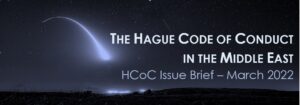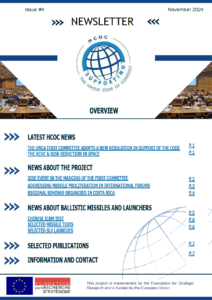Overcoming current and future challenges linked to missile proliferation:
Prospective analysis and possible ways forward for the HCoC
In-Depth Report
Ballistic missile development has become a major global security concern due to continuous technological advancements. Over the past decades, missile technology has evolved significantly, with key improvements in precision targeting, evasion techniques, and guidance systems that have made missile strikes more accurate. These developments have also made missiles harder to intercept, expanding their role in both state and non-state military strategies.
This report addresses four dimensions of missile proliferation: regional concerns, transfer to non-state actors, transformation of regulatory tools, and relations to space security. It studies in particular how these developments could impact the way the Hague Code of Conduct tackles missile proliferation and proposes ways forward.
JULY 2025
A report by the Ballistic Missile Non-Proliferation Youth Group
Missile proliferation remains one of the most pressing and complex challenges to international security in the twenty-first century. The global security landscape has been significantly reshaped by both the vertical and horizontal spread of ballistic and cruise missile technologies, exacerbated by shifting power dynamics, the erosion of arms control treaties, and the growing role of non-state actors in regional conflicts. These trends not only heighten the risk of escalation and miscalculation but also threaten to undermine the international non-proliferation architecture that has underpinned strategic stability for decades.
The Hague Code of Conduct against Ballistic Missile Proliferation (HCoC), established in 2002, remains the only multilateral transparency and confidence-building instrument specifically addressing the proliferation of ballistic missiles capable of delivering weapons of mass destruction (WMDs). With 145 subscribing states as of 2025, the HCoC plays a vital normative role in raising awareness about missile threats and promoting responsible behaviour through voluntary pre-launch notifications and annual declarations of policy. However, the evolving nature of missile technology, the emergence of regional missile races, and the limited universality and enforcement capacity of the HCoC highlight the need for reinvigorated action.
As missile capabilities grow more sophisticated with developments in hypersonic glide vehicles, anti-ship ballistic missiles (ASBMs), and enhanced missile precision, existing norms and mechanisms are being tested. At the same time, regional dynamics are creating new drivers of proliferation. In the Middle East, regional rivals have embraced ballistic missile programmes as strategic equalisers amid ongoing insecurity. East Asia, marked by North Korea’s rapidly advancing arsenal and the broader strategic competition among China, Japan, and South Korea, has become a flashpoint of missile development. In Southern Asia, the enduring rivalry between India and Pakistan, complicated by China’s presence, has entrenched a strategic logic favouring missile advancement over restraint. These regions are not only central to understanding global proliferation patterns but also serve as critical testing grounds for the relevance and applicability of the HCoC.
This policy brief addresses the main question: ‘How can the HCoC evolve to effectively respond to regional and global missile proliferation trends?’ To answer this, the brief is structured in four chapters.
Chapter 1 explores the question of how to regionalise a global norm, focusing on the HCoC’s adaptability and relevance in key geopolitical flashpoints: the Middle East, East Asia, and Southern Asia. While the HCoC is global in scope, missile proliferation is deeply influenced by regional threat perceptions, rivalries, and arms competition dynamics. Each region presents a unique case study on the drivers and trajectories of missile development. The chapter critically evaluates the extent to which the HCoC has been integrated within these regional contexts, and what can be done to localise its norms, foster transparency, and promote dialogue among rival states.
Chapter 2 examines the impact of ballistic missile technology advancements on international security. It focuses on Iran’s missile capabilities and their transfer to the Houthi movement in Yemen, which has extended conflict zones and empowered proxy groups. The chapter argues that emerging threats require an urgent reassessment of arms control mechanisms and concludes that strengthened international norms, regional cooperation, and adaptive multilateral efforts are essential to mitigate the destabilising effects of missile proliferation.
Chapter 3 calls for greater transparency and accountability within the HCoC framework and its complementary regimes, notably the Missile Technology Control Regime (MTCR). While both mechanisms contribute to the normative and technical governance of missile proliferation, their effectiveness remains limited by the voluntary nature of commitments, lack of universal adherence, and insufficient public disclosure of missile activities and policy rationales. This chapter highlights the importance of expanding participation and strengthening the reporting and notification mechanisms of the HCoC. It outlines practical steps towards enhancing confidence-building measures and improving data sharing between states and international institutions.
Chapter 4 addresses the intersection between missile non-proliferation and the peaceful uses of outer space. As access to space becomes increasingly democratised and commercialised, the dual-use nature of many space technologies raises serious concerns for the integrity of non-proliferation norms. This chapter examines current challenges to distinguishing between civilian and military space capabilities, the risks of technology diversion, and the potential for space-based missile systems to destabilise deterrence regimes. It further underscores the need to harmonise the principles of the HCoC with broader efforts to preserve space for peaceful purposes and calls for renewed multilateral engagement on space security governance.
Across all four chapters, this brief argues that the HCoC remains a critical foundation for a rules-based approach to missile non-proliferation. Yet, to remain credible and relevant, the HCoC must adapt to the realities of contemporary missile threats by embracing regional particularities, improving transparency, and addressing emerging technological domains such as hypersonics and outer space systems. The final section of this brief offers a set of forward-looking recommendations, aimed at reinvigorating the HCoC through enhanced multilateral cooperation, norm internalisation at the regional level, and more robust engagement with non-traditional actors and new technologies.



